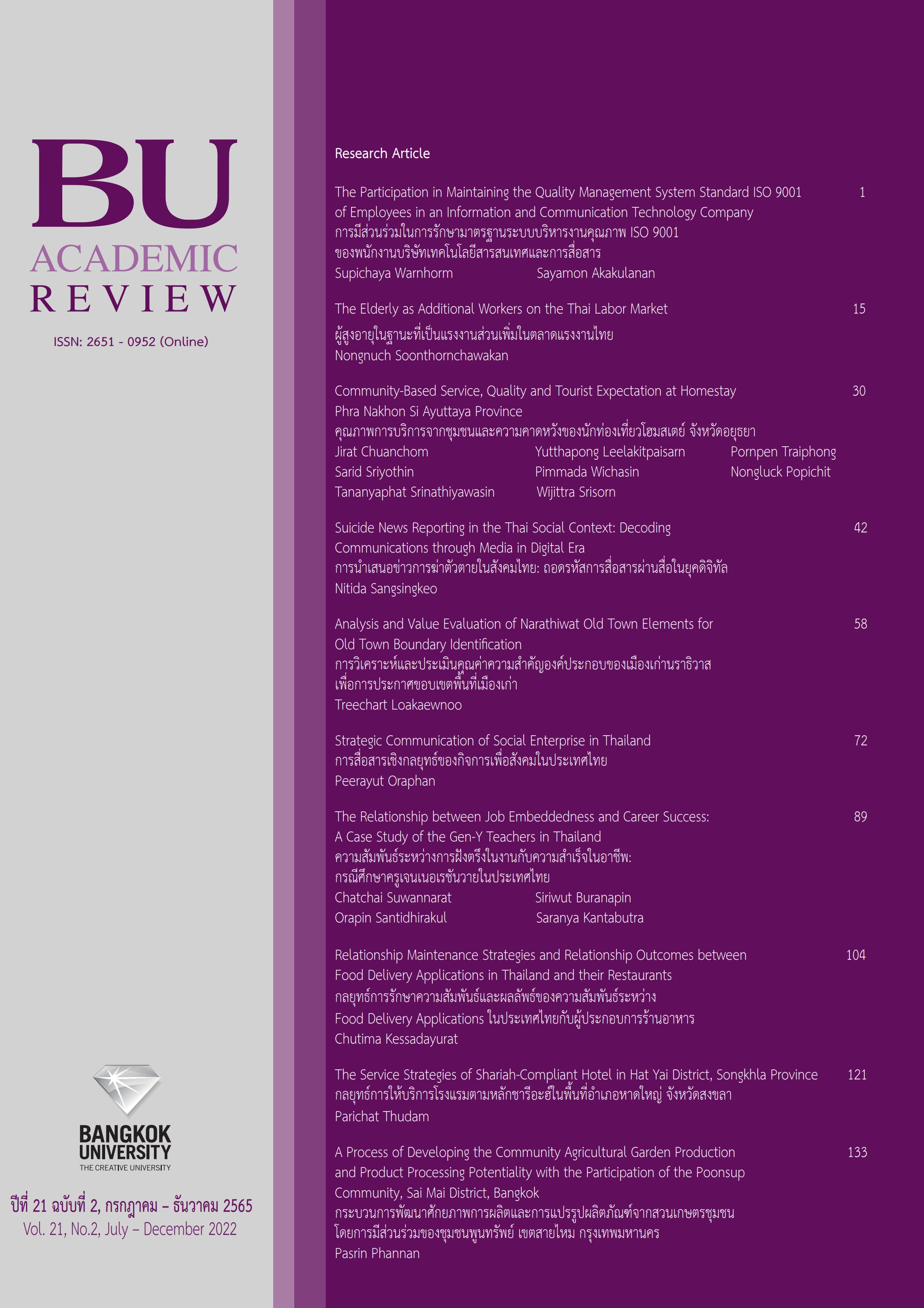Community-Based Service, Quality and Tourist Expectation at Homestay Phra Nakhon Si Ayuttaya Province
Main Article Content
Abstract
The aim of this study consist of the following: 1) To Study expectation and satisfaction of service homestay at Phra Nakhon Si Ayutthaya and 2) To study the activities in the homestay for tourists in Ayutthaya province, Mixed Research a quantitative research approach store data questionnaire with the reliability coefficient of 0.969 was conducted by collecting data from 400 questionnaires, a qualitative research Key informants are stakeholders with homestay operators including Entrepreneurs, business operators, homestays and community learning centers, local wisdom groups. Government workers involved in overseeing homestay business operations Tourists visiting the homestay included 50 key informants. The results found that 1) the expectation of service of the homestay for tourists ovrerall is high ( = 4.02) and Tourist’s satisfaction of service of the homestay in accommodating tourists ovrerall is very high (
= 4.42) 2) Koh kerd Home stay at Pang Pa-in is eco- tourism community Thai Herbal Learning Center, Next Sai noi homestay is ecotourism-village-ayutthaya Learn the conventional wisdom of Krungsri artisans through community activities such as learning to make mon bricks or strength training through traditional Muay Thai art activities and Khlong rang jorlake is Attractions and accommodation for those who want to relax, experience the fresh air, take a boat trip to see the villagers on both sides of the canal
Article Details

This work is licensed under a Creative Commons Attribution-NonCommercial-NoDerivatives 4.0 International License.
The manuscript submitted for publication must be the original version, submitted only to this particular journal with no prior acceptance for publication elsewhere in other academic journals. The manuscript must also not violate the copyright issue by means of plagiarism.
References
Cochran, W. G. (1977). Sampling techniques (3rd ed.). New York: John Wiley & Sons.
Cohen, J. M., & Uphoff, N. T. (1980). Participations place in rural development: Seeking clarity through specificity. New York: World Developments.
Department of Tourism, Government of Arunachal Pradesh. (2019). Operational guidelines for rural
tourism and homestays. India: Department of Tourism, Government of Arunachal Pradesh.
Division of Tourism and Sports Economy, Ministry of Tourism and Sports. (2021). Statistic international
tourist arrivals to Thailand. Retrieved June 29, 2021, from https://www.mots.go.th/news/category/629
Erdil, O., & Kalkan, A. (2010). The impacts of globalization on service quality and innovation of firms in
tourism sector in Antalya. In the Proceedings of 6th International Strategic Management Conference (pp.973-990). Saint Petersburg, Russia: Ankara.
Farsari, I., & Prastacos, P. (2001). Sustainable tourism indicators for Mediterranean established
destinations. Tourism Today, 1(1), 103-121.
Gilmore, J. H., & Pine, B. J. (2007). Authenticity: What consumers really want. Boston: Harvard
Business School.
Heung, V., & Cheng, E. (2000). Assessing tourists’ satisfaction with shopping in the Hong Kong special
administrative region of China. Journal of Travel Research, 38(4), 396-404.
Jamaluddin, M. R., Hanafiah, M. H., & Zulkifly, M. I. (2013). Customer-based psychology branding.
Procedia - Social and Behavioral Sciences, 105, 772-780.
Kasikornthai Research Center. (2020). COVID-19 traces the world tourism disruption expected contract
year by 38-45%. Retrieved June 29, 2020, from https://kasikornresearch.com/th/-analysis/k-
social-media/Pages/COVID-19-World-Tourism.aspx
Kotler, P., Keller, K. L., Ancarani, F., & Costabile, M. (2014). Marketing management (14th ed.). London:
Pearson Education.
Mosavi, S. A., & Ghaedi, M. (2012). A survey on the relationship between trust, customer loyalty,
commitment and repurchase intention. African Journal of Business Management, 6(36), 10089-
Oakley, P. (1991). Project with people. Geneva: International Labour Organisation.
Office of Permanent Secretary Ministry of Tourism and Sports. (2021). The second national tourism
development plan (2017 - 2021). Retrieved December 29, 2021, from file:///C:/Users/PPCCZAA/Downloads/roland_berger_the_second_national_tourism_development_plan_2017_2021.pdf
Payakwichien, P. (2001). Community residence homestay. TOT Booklet,41,10 tourism authority of
Thailand. 2001. The booklet guideline of tourism management in the responsible area of Sub-district Administration Organization and district council. Bangkok: Tourism Authority of Thailand.
Putro, S. W., Semuel, H., & Brahmana, R. K. (2014). Pengaruh kualitas layanan dan kualitas produk terhadap kepuasan pelanggan dan loyalitas konsumen restoran happy garden surabaya. Jurnal Manajemen Pemasaran, 2(1), 1-9.
Sallam, M. A. (2014). The effects of brand image and brand identification on brand love and
purchase decision making: The role of WOM. International Business Research, 7(10), 187–193.
Sarobol, S. (2004). Community based tourism management. Press release of research community.
The Thailand Research Fund (1st ed.). Chiang Mai: Wanida Karnpim.
Sharma, J. (2019). A study on acceptance of homestays as an emerging trend in alternate travel
accommodation in India: A case study of heritage house in Ahmedabad. Indian Journal of Hospitality Management, 1(1), 10-19.
Söderlund, M., & Rosengren, S. (2007). Receiving word-of-mouth from the service customer: An
emotion-based effectiveness assessment. Journal of Retailing and Consumer Services, 14(2),
-136.
The Ministry of Tourism and Sports Thailand (2021). The second national tourism development plan (2017 - 2021). Bangkok. Office of Permanent Secretary Ministry of Tourism and Sports.
World Tourism Organization [UNWTO]. (2017). UNWTO tourism highlight, 2017 Edition. Retrieved June 29, 2020, from https://www.e-unwto.org/doi/pdf/10.18111/9789284419029


